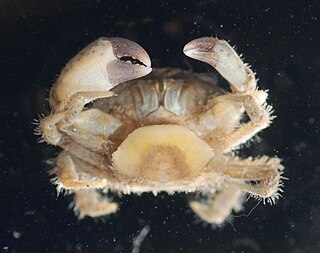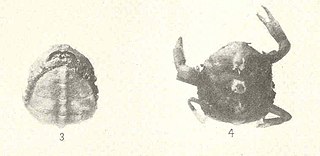
Panopeus herbstii, also known as the black-fingered mud crab, black-clawed mud crab, Atlantic mud crab or sometimes common mud crab, is a species of true crab, belonging to the infraorder Brachyura, and is the largest of the mud crabs.

Ocypode is a genus of ghost crabs found in the sandy shores of tropical and subtropical regions throughout the world. They have a box-like body, thick and elongated eyestalks, and one claw is larger than the other in both males and females. They inhabit deep burrows in the intertidal zone. They are primarily nocturnal, and are generalist scavengers and predators of small animals. The genus contains 21 species.

Grapsus grapsus is one of the most common crabs along the western coast of the Americas. It is known as the red rock crab, or, along with other crabs such as Percnon gibbesi, as the Sally Lightfoot crab.

Maja brachydactyla is a species of crab in the family Majidae. It was initially described as a subspecies of M. squinado. A review of the species complex published in 1998 was able to differentiate between specimens from the Mediterranean Sea and those from the Atlantic Ocean, and concluded that the Atlantic specimens were a separate species, accepted as M. brachydactyla Balss, 1922.

Menippe nodifrons, commonly known as the Cuban stone crab, is a species of crab found in warm tropical waters of the western Atlantic Ocean. It is common in parts of Brazil, and is found in the United States in east-central Florida and off the coast of Louisiana.

Xantho poressa, the jaguar round crab, is a species of crab from the eastern Atlantic Ocean. It is one of four species in the genus Xantho.
Melybia thalamita is a species of crab in the family Xanthidae, the only species in the genus Melybia. It is found in the western Atlantic Ocean, from Florida and the Gulf of Mexico south to São Paulo, Brazil, at depths of 10–200 metres (33–656 ft).

The Panopeidae are a family containing 26 genera of morphologically similar crabs, often known as "mud crabs". Their centers of diversity are the Atlantic Ocean and eastern Pacific Ocean.

Dyspanopeus sayi is a species of mud crab that is native to the Atlantic coast of North America. It has also become established outside its native range, living in Swansea Docks since 1960, the Mediterranean Sea since the 1970s, the North Sea since 2007 and the Black Sea since 2010. It can reach a carapace width of 20 mm (0.8 in), and has black tips to its unequal claws. It feeds on bivalves and barnacles, and is in turn eaten by predators including the Atlantic blue crab, Callinectes sapidus. Eggs are produced from spring to autumn, the offspring reach sexual maturity the following summer, and individuals can live for up to two years. The closest relative of D. sayi is D. texanus, which lives in the Gulf of Mexico; the two species differ in subtle features of the genitalia and the last pair of walking legs.
Libinia ferreirae is a species of tropical spider crab in the family Epialtidae. It is found on the seabed in shallow waters off the Atlantic coast of South America.

Alpheus heterochaelis, the bigclaw snapping shrimp, is a snapper or pistol shrimp in the family Alpheidae. It is found in the western Atlantic Ocean and the Gulf of Mexico.

Dyspanopeus texanus is a species of crab known as the Texas mud crab.

Portunus sayi, the sargassum swimming crab, is a species of pelagic crab in the family Portunidae. It is found in the western Atlantic Ocean and the Caribbean Sea where it makes its home among floating mats of Sargassum seaweed. It was named in honour of the American naturalist Thomas Say.

Loxothylacus panopaei is a species of barnacle in the family Sacculinidae. It is native to the Gulf of Mexico and the Caribbean Sea. It is a parasitic castrator of small mud crabs in the family Panopeidae, mostly in the Gulf of Mexico, the Caribbean Sea and the eastern Atlantic Ocean.
Panopeus lacustris, the knot-fingered mud crab, is a true crab belonging to the infraorder Brachyura. It can be distinguished from related species by its exceptionally broad and knobbly main chela (claw).

Eurypanopeus depressus, the flatback mud crab or depressed mud crab, is a true crab belonging to the infraorder Brachyura and the family Panopeidae. It is native to the western Atlantic Ocean and is often found in estuaries and lagoons, commonly living in close association with oysters.

Tunicotheres is a monotypic genus of crabs in the family Pinnotheridae, and Tunicotheres moseri is the only species in the genus. This crab lives commensally in the atrial chamber of a small ascidian. It is found in the tropical western Atlantic Ocean, the Caribbean Sea and the Gulf of Mexico.
Calyptraeotheres garthi is a species of pea crab in the family Pinnotheridae. It is found in the southwestern Atlantic Ocean and is a parasitic castrator of the slipper limpet Crepidula cachimilla.

Austruca is a genus of indo-west Pacific fiddler crabs in the family Ocypodidae. There are about 13 described species in this genus.















